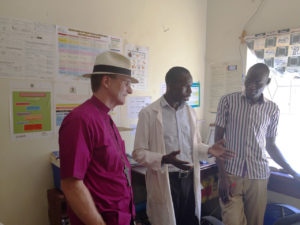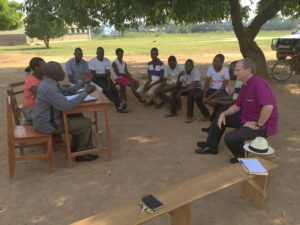Beacon of Hope Clinic is a small operation— a consultation room, two examining rooms, a small lab with basic equipment— two electric microscopes, a centrifuge, battery-powered backup for both— and a dispensary. They serve the kids and faculty at the school next door, but they also provide valuable ministry to the local community and beyond. People from a remote village have been known to walk all day with a sick child in order to have the baby treated by our doctor, nurse and social worker.
But we have come so far. Now we have a secure internet connection, wi-fi, digital record keeping, a comfortable waiting area with a TV, even ergonomically designed chairs for our staff. The first time I ever saw these rooms, they were nearly bare, scarcely any medicine available, chickens wandering in and out of the waiting room. As a reminder of those days, we still have an old manual centrifuge mounted to the table with a vice, and on bad power days, the staff still use it. It reminds me of a big pencil-sharpener (I wish I had taken a picture of the thing itself!) and we can do very little with it, but it can at least give us an idea if someone has malaria or not.
Malaria is the enemy. The overwhelming majority of cases that come to the clinic involve malaria, and most of those are children. When the parasite kills, most of the victims are kids under the age of five or pregnant women. Much of the population in Teso, at any given time, struggles with recurrences of malaria.
The clinic nearly pays for itself, and is still able to offer treatment to the indigent. Many lives have been saved through this work. But we are hoping that Pilgrim will be playing a major role in the eventual elimination of malaria, through the protocol we will soon be launching in Katakwi. Nothing would make us happier than to see this clinic put out of business in that way.
In the afternoon, I visit with a team from various churches who committed last year to try to establish an A.A.-style recovery intuitive in Soroti. Fr. Jay Geisler and I spent a lot of time laying the groundwork for this effort in 2014 and 2015. The results have been slow in coming. The ajono groups, local drinking societies which I have written about before, are very resistant to the idea that they feed alcohol addiction. They think that they actually take care of unruly members, and treat heavy drinkers simply by telling them they can’t have any more of the local brew today. They are also skeptical of the churches, which they feel insist that people give up drinking before they are allowed in the doors. A.A. is not that kind of program, obviously, but that is precisely what makes it so unfamiliar.
So the team has begun by trying to build relationships with members of these societies. They are starting a soccer club and inviting members to join and play. They also have an idea to begin a “savings circle”— essentially a small scale S&L or credit union— and offer it to members of the drinking groups, and are looking at possibilities for setting up a small manufacturing business in which unemployed people could participate (unemployment among men in Teso is close to 80%). These are all wonderful ideas, but the “low-hanging fruit” has still not been picked— such as translating the 12 steps into Ateso, producing 54 messages on alcohol addiction for use on Sundays in the churches, and so forth. This is simply because initiative on any level in this region frequently gets stopped by the endemic effects of poverty and disease. Nonetheless these faithful people continue. They show up at the societies, make friends, don’t judge, don’t preach, wait on God.
So, after this meeting we go visit my old friend David, the mayor of Pamba, who is also the President of the ajono group there. He is not there when we arrive, and the gathering is sparse, probably fewer than twenty five or so on a Saturday afternoon. Our welcome is cool. There is a sort of sullenness I haven’t met with before. Then David shows up, greets me warmly, and the ice breaks a little. He explains that both the dark mood and the small numbers are because the crops have failed. The rains came for only two months and then stopped completely, and the young plants burned to death in the sun. So people have no food and no money, which means they can barely feed themselves, let alone drink. However, as I look around, it is pretty clear to me that some of the members have chosen to drink first and eat later, if at all.
We bid good-bye and the team breaks up, agreeing to meet again on Tuesday to process what we have experienced.
I can’t help but thinking of the difference between the two kinds of illness I have spent time with this day. People with malaria usually run for help; but people who are addicted often run the opposite direction, move more deeply into their illness rather than away from it. The Iteso have a proverb that describes what so often happens: a man drinks with friends, but he dies alone. I am praying that the Church here may actually begin to have the same effect on addiction, that Pilgrim hopes to have on malaria.


